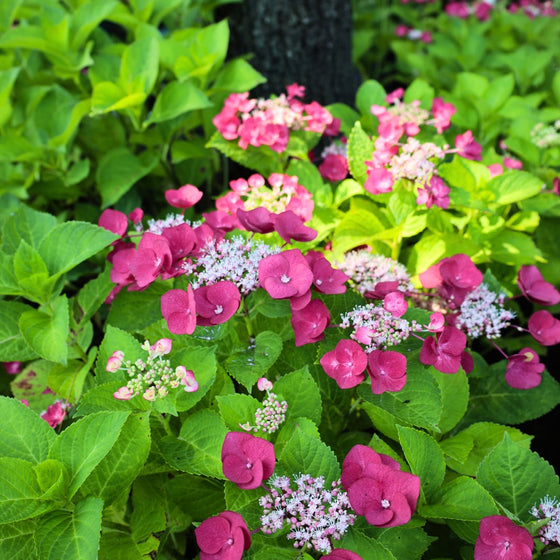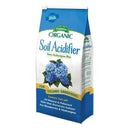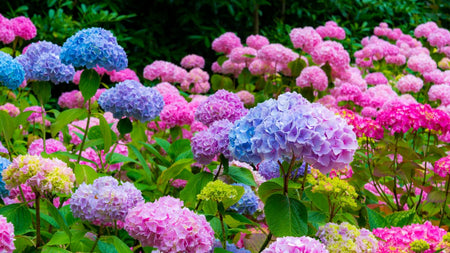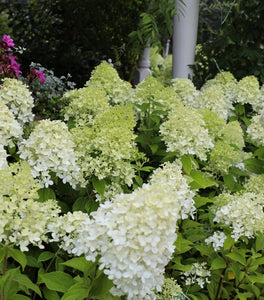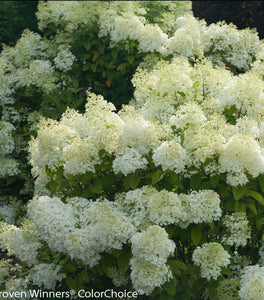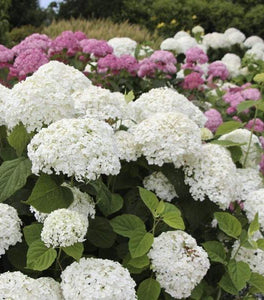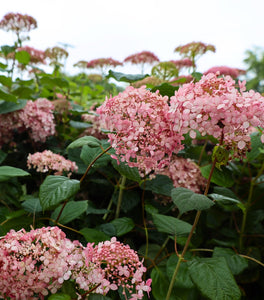
Images Depict Mature Plants
Cherry Explosion Hydrangea Shrubs for Sale Online
Cherry Explosion Hydrangea (Hydrangea macrophylla 'McKay') is the reddest hydrangea shrub out there! One of the smallest hydrangeas on the market, it rarely needs pruning. If you're looking for a low-maintenance, compact flowering shrub with lots of color and little hassle, look no further.
Cherry Explosion keeps its red color in most soils, developing only purplish centers in acidic soils. The lace-cap blooms consist of a mound of cherry-red flowers that last through the entire flowering season, June thru September! Its lush foliage and plentiful blossoms create a stunning summer statement in any garden or landscape.
Cherry Explosion Hydrangea Shrubs do well as mass plantings, and borders, but its compact size makes it ideal for container plantings as well.
Decorate your patio, porch, or entryway with potted Hydrangea, and take cuttings at the end of the season to enjoy as-dried flower arrangements all winter. Ideal for rustic and cottage gardens, Cherry Explosion Hydrangea is well-loved for its versatility and compact growth habit.
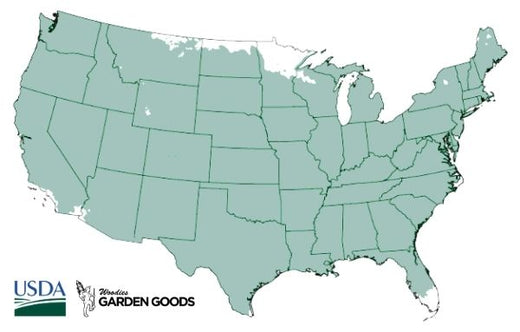
| Hardiness Zone: | 4-9 |
|---|---|
| Mature Height: | 3 to 4 Feet |
| Mature Width: | 3 to 4 Feet |
| Classification: | Broad leaved deciduous shrub, summer flowering |
| Sunlight: | Part sun to full sun |
| Habit: | Upright, densely branched, mounding |
| Foliage: | Dark-green |
| Flower Color: | Cherry red |
| Pruning Season: | Light pruning in the spring |
| Soil Condition: | Any well drained soil |
| Water Requirements: | Water well until established |
| Uses: | Extremely attractive when used as a focal point in the mixed border, mass planting, or a specimen planting |
How to Care for Cherry Explosion™ Hydrangea
Be sure to read our planting instructions to ensure a healthy and happy plant for years to come!

Planting Cherry Explosion Hydrangea Shrubs
We suggest when planting your newly purchased Cherry Explosion Hydrangea Shrubs that you dig a hole twice as wide as the root system but not deeper. Depending on the quality of your existing soil, you may need to add a locally-sourced compost or topsoil to the backfill soil. We do not recommend using straight topsoil or compost as a backfill soil for Cherry Explosion because more times than not these products will retain entirely to much moisture and will cause the root system to rot. Adding compost or topsoil will help the young feeder roots of Cherry Explosion Hydrangea spread through the loose, nutrient-rich soil much easier than if you used solely the existing soil, which more times than not will be hard and compacted. The most common cause of plant death after transplanting is planting the new plant too deep. That is why we do not recommend planting in a hole any deeper than the soil line of the plant in the pot. A good rule is that you should still be able to see the soil the plant was grown in after back-filling the hole. Bio-tone starter fertilizer is a great starter fertilizer that provides plants with mycorrhizae fungus. It is a naturally-occurring, beneficial fungus that colonizes on the new growing roots of plants. It creates a barrier between the roots of the plant and fungus and pathogens that can cause root rot. We love this product and use it on all plants we install in our own gardens. Bio-tone is a gardener's best friend and can help guarantee your success.
Watering Cherry Explosion Hydrangea Shrubs
After back filling and lightly compacting the 50/50 mix of existing soil and compost give the Cherry Explosion Hydrangea a good, deep watering. This is not to be rushed. Most of the water you put on the plant at first will run away from the plant until the soil is soaked. A general rule of thumb is to count to 5 for every one gallon of pot size. For example, a one gallon pot would be watered until you count to 5; a three gallon pot would be 15; and so on. Check the plant daily for the first week or so and then every other day there after. Water using the counting method for the first few weeks.
Understanding Fertilizer Labels for Hydrangea Shrubs
When looking at most fertilizers, they are described by three numbers on the bag. An example would be 10-10-10 or 12-4-8. The first of these three numbers refers to Nitrogen, which is the primary element necessary for good, balanced growth within the hydrangea. Plants that are deficient in Nitrogen are usually not growing vigorously, and sometimes exhibit pale-colored foliage. Not all Nitrogen deficiencies result in stunted growth. Sometimes, the growth is taller and longer with less-than-desirable branching when Nitrogen is deficient. The second number in the fertilizer equation is representative of Phosphorus. A deficiency of Phosphorus may affect the energy transfer in the plant, and result in stunted growth as well. Also, plants with insufficient amounts of Phosphorus may have poorer root systems. Potassium is the element represented by the third number on the fertilizer bag. Plants that are deficient in Potassium are usually growing more slowly than normal, have fewer flowers and seed, and are more susceptible to disease than plants with adequate levels of Potassium. Although the three elements just mentioned are the major elements necessary for good plant performance, there some minor elements that are just as important in consideration of Cherry Explosion Hydrangea nutrition. Minor elements that are not included in the three numbers listing on the front of fertilizer bags are very important considerations when choosing your hydrangea fertilizer. Elements such as Magnesium, Sulfur, Calcium, Iron, Manganese, Copper, Zinc, Boron, and Molybdenum play very important roles in providing hydrangeas with adequate nutrition. Many times, less expensive fertilizers are sold that contain only the major elements needed, but not the minor elements. Always be sure to look on the fertilizer label on the back of the bag to see exactly what is included in the fertilizer. In choosing the basic type of fertilizer for your Cherry Explosion Shrubs, it is important to determine what you need your Hydrangeas to do. If your plants are well established, and you are not concerned about more growth, choose a fertilizer that has a smaller first number, and a larger second and third number. When you have selected your fertilizer and are ready to apply it, be sure to rake your mulch back to the drip line of each plant. Apply the fertilizer according to the label directions immediately on top of the soil, and be sure to water the plant thoroughly after the application. You can then rake the mulch back around the base of the Cherry Explosion Hydrangea. Although it is tempting to spend less time by not raking the mulch back during fertilization, the results will be less than desirable, if the fertilizer is applied on top of the mulch. Proper fertilization of your Cherry Explosion Hydrangea will lead to healthier and more disease-resistant plants, as well as provide you with many more enjoyable blooms. Always read the label on your fertilizer bag, and follow the instructions.


